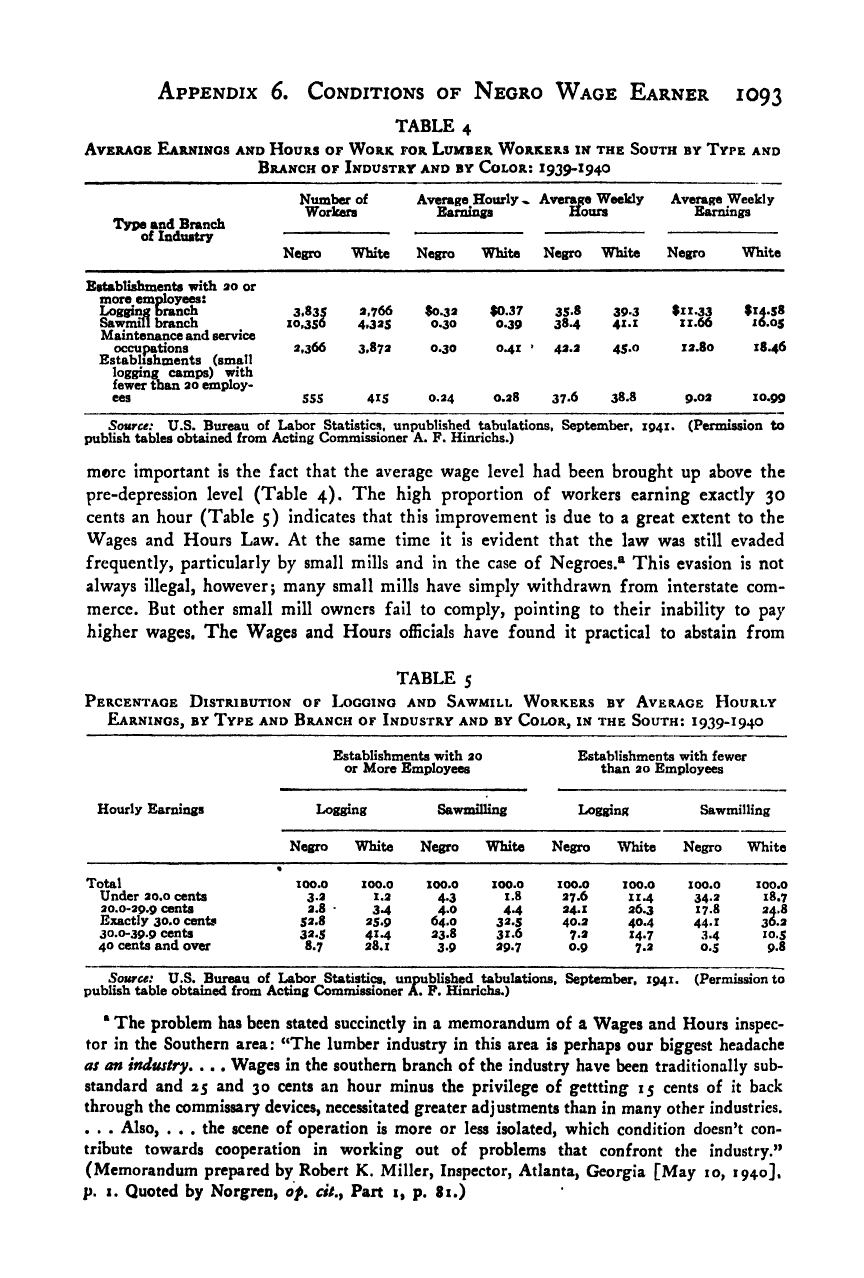Note: Gunnar Myrdal died in 1987, less than 70 years ago. Therefore, this work is protected by copyright, restricting your legal rights to reproduce it. However, you are welcome to view it on screen, as you do now. Read more about copyright.
Full resolution (TIFF) - On this page / på denna sida - Appendices - 6. Pre-War Conditions of the Negro Wage Earner in Selected Industries and Occupations - 5. Lumber

<< prev. page << föreg. sida << >> nästa sida >> next page >>
Below is the raw OCR text
from the above scanned image.
Do you see an error? Proofread the page now!
Här nedan syns maskintolkade texten från faksimilbilden ovan.
Ser du något fel? Korrekturläs sidan nu!
This page has never been proofread. / Denna sida har aldrig korrekturlästs.
Appendix 6. Conditions of Negro Wage Earner 1093
TABLE 4
Average Earnings and Hours of Work for Lumber Workers in the South by Type and
Branch of Industry and by Color: 1939-1940
Type and Branch
of Industry
Establishments with 20 or
more employees:
Logging branch
Sawmill branch
Maintenance and service
occupations
Establishments (small
logging camps) with
fewer than 20 employ*
ees
Number of Average Hourly ^
Workers Earnings
Negro White Negro White
3.83s
10,350
2,766
4.32s
$0.32
0.30
$0.37
0.39
2,366 3.872 0.30 0.41
SSS 41S 0.24 0.28
Average Weekly Average Weekly
Hours Earnings
Negro White Negro White
35.8
38.4
39-3
41.
1
$11.33
11.66
$14.58
16.05
42.2 45.0 Z2.80 18.46
37.6 38.8 9.02 10.99
Source: U.S. Bureau of Labor Statistics, unpublished tabulations, September, 1941. (Permission to
publish tables obtained from Acting Commissioner A. F. Hinrichs.)
more important is the fact that the average wage level had been brought up above the
pre-depression level (Table 4). The high proportion of workers earning exactly 30
cents an hour (Table 5) indicates that this improvement is due to a great extent to the
Wages and Hours Law. At the same time it is evident that the law was still evaded
frequently, particularly by small mills and in the case of Negroes.*^ This evasion is not
always illegal, however; many small mills have simply withdrawn from interstate com-
merce. But other small mill owners fail to comply, pointing to their inability to pay
higher wages. The Wages and Hours officials have found it practical to abstain from
TABLE 5
Percentage Distribution of Logging and Sawmill Workers by Average Hourly
Earnings, by Type and Branch of Industry and by Color, in the South: 1939-1940
Establishments with 20
or More Employees
Establishments with fewer
than 20 Employees
Hourly Earnings Logging Sawmilling Logging Sawmilling
Negro White Negro White Negro White Negro White
btal
%
100.0 xoo.o 100.0 100.0 100.0 xoo.o 100.0 100.0
Under 20.0 cents Z.2 4.3 X.8 27.6 11.4 34-2 18.7
20.0-29.9 cents 2.8 3.4 4.0 4.4 24.x 26.3 17.8 24.8
Exactly 30.0 cents 52.8 25-9 64.0 32.5 40.2 40.4 44.1 30.2
30.0-39.9 cents 32.S 41.4 23.8 31.6 7.2 14.7 3.4 lo.s
40 cents and over 8.7 28.1 3.9 29.7 0.9 7.2 0.5 9.8
Source: U.S. Bureau of Labor Statistics, unpublished tabulations, September, 1941. (Permission to
publish table obtained from Acting Commissioner A. P. Hinrichs.)
• The problem has been stated succinctly in a memorandum of a Wages and Hours inspec-
tor in the Southern area: “The lumber industry in this area is perhaps our biggest headache
as an industry* . . . Wages in the southern branch of the industry have been traditionally sub-
standard and 25 and 30 cents an hour minus the privilege of gettting 15 cents of it back
through the commissary devices, necessitated greater adjustments than in many other industries.
. . . Also, . . . the scene of operation is more or less isolated, which condition doesn’t con-
tribute towards cooperation in working out of problems that confront the industry.”
(Memorandum prepared by Robert K. Miller, Inspector, Atlanta, Georgia [May 10, 1940].
p. 1. Quoted by Norgren, op. cit.y Part 1, p. 81.)
<< prev. page << föreg. sida << >> nästa sida >> next page >>